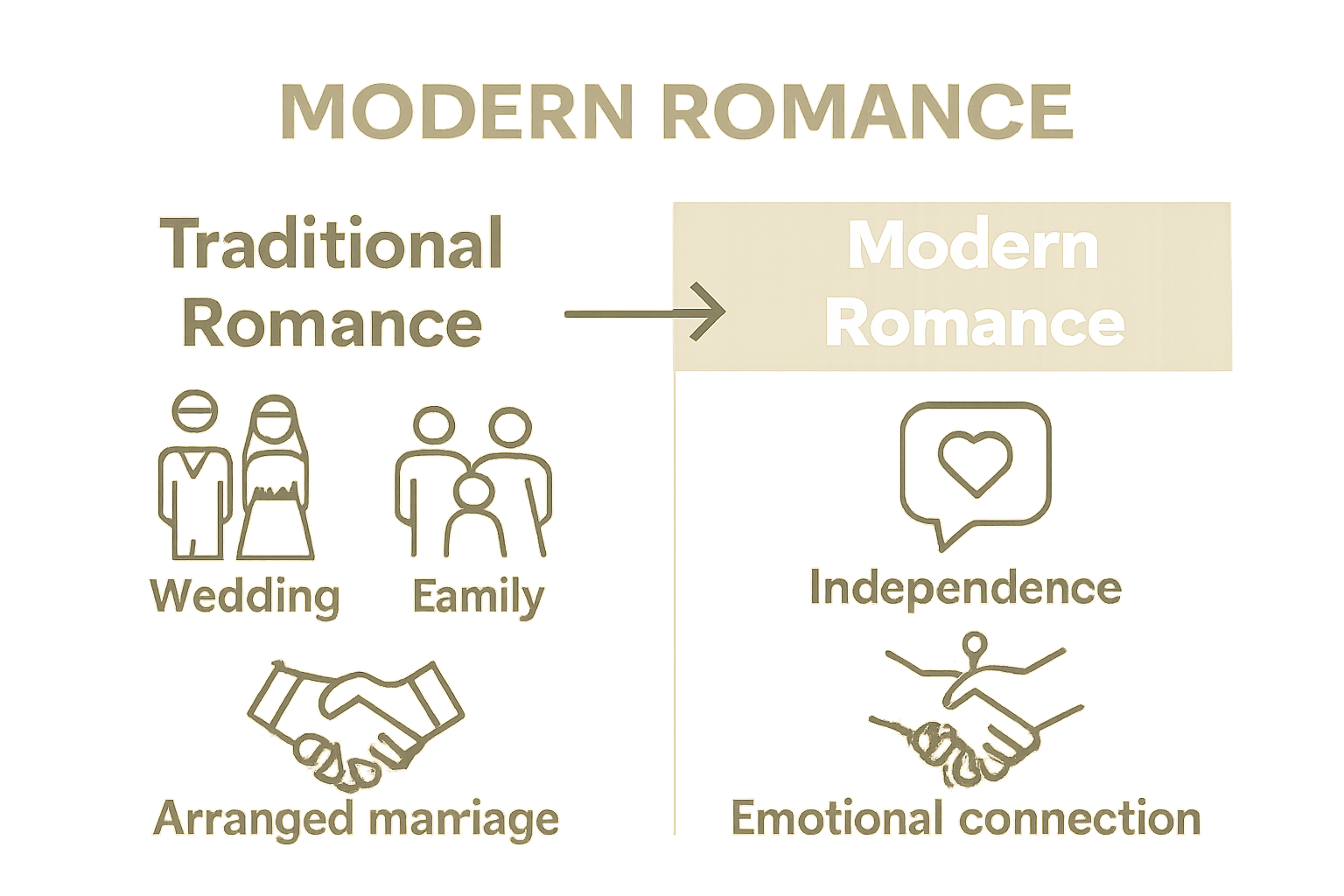What is Modern Romance? Understanding Love Today
Love is not what it used to be, and that’s more than just nostalgia. Couples today are turning tradition on its head with one massive shift. Over 40 percent of couples now meet online instead of through friends or family. People often assume technology makes romance shallow or transactional, but the real surprise is how modern romance has become more about authenticity, self expression, and true emotional connection than ever before.
Table of Contents
- The Evolution Of Romance: From Traditional To Modern
- Understanding The Impact Of Technology On Relationships
- Key Themes Of Modern Romance: Connection, Vulnerability, And Authenticity
- Cultural Influences On Contemporary Romantic Expectations
- Navigating Modern Romance: Challenges And Opportunities
Quick Summary
| Takeaway | Explanation |
|---|---|
| Modern romance prioritizes individual choice and emotional compatibility. | Contemporary relationships focus on personal goals, mutual understanding, and emotional support over traditional constraints. |
| Technology expands romantic possibilities but complicates communication. | Digital platforms create opportunities for connection, yet may lead to emotional distance and superficial interactions. |
| Emotional vulnerability is essential for deep connections. | Sharing true feelings fosters trust and intimacy, transforming vulnerability into a strength in relationships. |
| Authenticity shapes modern relationship dynamics. | Partners today seek genuine emotional communication and reject performative behaviors, facilitating true intimacy. |
| Cultural influences redefine romantic expectations. | Different cultural perspectives shape relationship norms, balancing individual desires with collective values. |
The Evolution of Romance: From Traditional to Modern
Modern romance represents a profound transformation in how individuals approach relationships, moving far beyond traditional constraints and expectations. Psychological research reveals that contemporary romantic connections are increasingly characterized by personal agency, emotional compatibility, and individual fulfillment.
Shifting Relationship Paradigms
Traditional romance was predominantly structured around societal expectations, economic considerations, and familial arrangements. Marriages were often strategic alliances designed to secure financial stability, social status, or continue family lineages. Women had limited autonomy in selecting partners, with marriages frequently negotiated by families based on practical considerations rather than emotional connection.
In contrast, modern romance prioritizes individual choice, emotional resonance, and mutual understanding. People now seek partners who complement their personal goals, share similar values, and provide emotional support. This shift reflects broader social changes, including increased gender equality, economic independence, and evolving cultural norms that celebrate personal happiness and self-actualization.

Technology and Connection
Digital platforms have dramatically reshaped romantic interactions, creating unprecedented opportunities for connection beyond geographical and social boundaries. Online dating apps and social media platforms enable individuals to meet potential partners with shared interests, expanding romantic possibilities exponentially.
Key characteristics of modern romance include:
- Greater emphasis on personal compatibility
- Increased acceptance of diverse relationship structures
- More fluid definitions of commitment and partnership
- Enhanced communication through digital platforms
- Reduced societal pressure regarding traditional relationship milestones
The contemporary romantic landscape celebrates individual agency, emotional intelligence, and genuine connection, marking a significant departure from historical relationship paradigms.
To help clarify the differences and similarities between traditional and modern romance, the following table compares their key characteristics mentioned in the article.
| Aspect | Traditional Romance | Modern Romance |
|---|---|---|
| Basis for Partnership | Societal expectations, economic/family arrangements | Individual choice, emotional resonance, mutual understanding |
| Autonomy in Selection | Limited, often family-negotiated | High, based on personal goals and preference |
| Role of Emotional Connection | Less prioritized, practical focus | Central; strong emphasis on emotional compatibility |
| Gender Roles | Rigid, patriarchal | Greater gender equality and shared decision making |
| Commitment Definitions | Fixed, conventional milestones | Fluid, personally defined, open to diverse structures |
| Impact of Technology | Minimal, face-to-face/social network dependent | Significant; online platforms expand connection opportunities |
| Cultural Pressure | Strong adherence to traditional norms | Reduced, more acceptance of personal agency and expression |
Understanding the Impact of Technology on Relationships
Technology has fundamentally transformed how individuals connect, communicate, and cultivate romantic relationships in the 21st century. Stanford University research demonstrates that digital platforms have revolutionized interpersonal dynamics, creating complex new paradigms of intimacy and connection.
Digital Connection Platforms
Online dating platforms and social media have dramatically expanded romantic opportunities. Where traditional matchmaking relied on geographical proximity and social networks, digital technologies now enable connections across unprecedented distances. Users can now interact with potential partners who share specific interests, values, and life goals, transcending traditional social barriers.
These platforms utilize sophisticated algorithms that analyze user preferences, behavioral patterns, and compatibility metrics. By leveraging data science, these technologies create more nuanced matching processes that go beyond superficial physical attraction, focusing instead on deeper emotional and intellectual compatibility.
Communication Transformation
Digital communication technologies have fundamentally altered relationship communication patterns. Instant messaging, video calls, and social media platforms allow continuous connectivity, enabling couples to maintain intimacy regardless of physical distance. This constant communication creates new relationship dynamics, where emotional proximity is no longer strictly dependent on physical presence.
Significant technological impacts on relationships include:
- Expanded romantic connection possibilities
- More transparent communication channels
- Increased opportunities for long distance relationships
- Enhanced ability to verify potential partner backgrounds
- Reduced geographical limitations in partner selection
However, these technological advances also introduce complex challenges.
The following table outlines the key impacts of technology on romantic relationships as detailed in the article, making it easier to understand both the opportunities and challenges presented.
| Impact Area | Positive Effect | Challenge/Risk |
|---|---|---|
| Romantic Connection | Expands partner possibilities beyond geography | Risk of superficial or transactional interactions |
| Communication | Allows continuous, instant connectivity | Potential illusion of connection, less depth |
| Background Verification | Easier vetting through digital footprints | Privacy concerns, incomplete understanding |
| Long Distance Relationships | Enables maintenance across distances | Harder to establish true intimacy |
| Matching & Compatibility | Uses algorithms for nuanced matches | Overreliance on metrics, overlooked chemistry |
Key Themes of Modern Romance: Connection, Vulnerability, and Authenticity
Modern romance has emerged as a deeply nuanced experience that transcends traditional relationship expectations, focusing on genuine emotional connection and personal authenticity. Research on romantic relationships highlights how contemporary partnerships prioritize emotional depth and mutual understanding.
Emotional Vulnerability as Strength
Contrary to historical perspectives that viewed emotional vulnerability as weakness, modern romance celebrates it as a foundational element of meaningful connections. Partners are increasingly encouraged to share their authentic feelings, fears, and aspirations without fear of judgment. This approach transforms vulnerability from a perceived liability into a powerful mechanism for building trust and intimacy.
Emotional transparency allows individuals to create deeper, more meaningful relationships by dismantling traditional barriers of emotional reserve. By embracing vulnerability, partners demonstrate courage and create spaces for genuine understanding and mutual growth.
Authentic Self Expression
Authenticity has become a cornerstone of contemporary romantic relationships. Modern partners seek connections that allow them to present their true selves, rejecting performative relationship dynamics. This shift represents a significant departure from historical models where individuals often felt pressured to conform to external expectations or societal norms.
Key principles of authentic romantic connection include:
- Prioritizing genuine emotional communication
- Rejecting societal relationship scripts
- Valuing individual differences
- Embracing personal growth within partnerships
- Maintaining individual identity alongside romantic commitment
These principles reflect a profound understanding that true intimacy emerges from accepting and celebrating each partner’s authentic self.
 Explore our guide on redefining femininity to understand how personal authenticity transforms relationship dynamics.
Explore our guide on redefining femininity to understand how personal authenticity transforms relationship dynamics.
Modern romance ultimately represents a holistic approach to love that honors individual complexity, emotional intelligence, and genuine human connection.
Cultural Influences on Contemporary Romantic Expectations
Romance is a complex, dynamic experience profoundly shaped by cultural contexts and societal norms. Cross-cultural research reveals how diverse global perspectives dramatically transform romantic interactions and relationship expectations.
Global Perspectives on Love
Different cultures interpret romantic relationships through unique cultural lenses, reflecting deep-rooted social values and traditions. Western societies typically emphasize individual emotional choice and personal compatibility, whereas many Eastern and collectivist cultures prioritize familial approval, long-term stability, and communal considerations in romantic partnerships.
In some cultures, arranged marriages remain prevalent, with families playing a central role in partner selection. Conversely, individualistic societies place greater emphasis on personal chemistry, emotional connection, and mutual attraction as foundational relationship criteria. These divergent approaches demonstrate how cultural frameworks fundamentally shape romantic experiences.
Evolving Gender Dynamics
Cultural expectations surrounding gender roles significantly influence romantic interactions. Traditional patriarchal models that prescribed rigid relationship dynamics are increasingly challenged by more egalitarian perspectives. Modern romantic relationships increasingly value partnership, mutual respect, and shared decision making across diverse cultural contexts.
Key cultural transformations in romantic expectations include:
- Reduced emphasis on traditional gender hierarchies
- Increased acceptance of diverse relationship structures
- Growing recognition of emotional intelligence
- Prioritization of personal agency in partner selection
- Rejection of restrictive societal relationship scripts
Explore our fashion inspiration guide to understand how personal style reflects these evolving cultural narratives.
Ultimately, contemporary romance represents a nuanced negotiation between individual desires and broader cultural contexts, celebrating human connection across diverse global perspectives.
Navigating Modern Romance: Challenges and Opportunities
Modern romantic landscapes present a complex terrain of unprecedented possibilities and nuanced challenges. Psychological research reveals that contemporary dating environments require sophisticated emotional intelligence and adaptive strategies.
Digital Age Relationship Dynamics
The proliferation of digital platforms has fundamentally transformed romantic interactions. Online dating applications and social media have expanded potential connection opportunities while simultaneously introducing complex psychological challenges. Digital environments create both connection and disconnection, enabling individuals to meet potential partners globally while also generating unprecedented levels of romantic uncertainty.
Individuals now navigate intricate digital relationship protocols, managing expectations across multiple communication channels. The ability to instantly connect paradoxically coexists with increased emotional distance, challenging traditional relationship development models.
Emotional Complexity and Self Awareness
Modern romance demands heightened emotional sophistication. Partners must develop nuanced communication skills, emotional transparency, and self reflection. The traditional linear relationship progression has been replaced by more fluid, individually negotiated romantic experiences that prioritize personal growth and mutual understanding.
Key challenges in contemporary romantic navigation include:
- Managing digital communication expectations
- Balancing individual independence with relationship intimacy
- Navigating diverse relationship structure possibilities
- Maintaining authentic emotional connections
- Processing rapid technological relationship transformations
Explore our everyday outfit inspiration to understand how personal style reflects these evolving relational complexities.
Ultimately, modern romance represents a dynamic journey of continuous learning, requiring emotional agility, technological savviness, and a commitment to genuine human connection.
Redefine Your Modern Love Story with Be Juliet
Modern romance brings both freedom and complexity. The article highlights how today’s relationships are shaped by emotional authenticity, self-expression, and the challenge of finding genuine connection in a digital world. Many women are seeking ways to show their true selves and embrace every aspect of who they are, from empowered moments to days spent in quiet comfort. Yet it can be hard to feel confident and comfortable while honoring the ever-changing journey of love and identity. If you crave outfits that keep up with your evolving story—bold when you need it and gentle when you want it—Be Juliet is here to help you dress for every chapter.

Step into a wardrobe that celebrates all the nuances of modern femininity. Discover fashion that inspires self-expression, shop everyday looks that fit both your mood and your lifestyle, and claim confidence for every occasion. Visit Be Juliet today and make your everyday moments a reflection of the love you deserve. Your journey toward authenticity and style starts now.
Frequently Asked Questions
What defines modern romance today?
Modern romance is characterized by individual agency, emotional compatibility, and a focus on mutual fulfillment, moving beyond traditional constraints and societal expectations.
How has technology influenced romantic relationships?
Technology has transformed romantic interactions by enabling connections across distances through online dating platforms and social media, allowing for greater compatibility and communication options.
What role does emotional vulnerability play in contemporary relationships?
Emotional vulnerability is now seen as a strength in modern romance, allowing partners to build deeper connections through authentic sharing of feelings, fears, and aspirations.
How do cultural influences shape romantic expectations in the modern world?
Cultural perspectives significantly affect romantic interactions, as different societies prioritize various values such as individual choice or familial approval, reflecting broader social dynamics and expectations.
